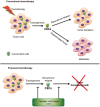Autophagy in Cancer Stem Cells: A Potential Link Between Chemoresistance, Recurrence, and Metastasis
- PMID: 26309786
- PMCID: PMC4497670
- DOI: 10.1089/biores.2014.0035
Autophagy in Cancer Stem Cells: A Potential Link Between Chemoresistance, Recurrence, and Metastasis
Abstract
Cancer cells require an uninterrupted nutritional supply for maintaining their proliferative needs and this high demand in concurrence with inadequate supply of blood and nutrition induces stress in these cells. These cells utilize various strategies like high glycolytic flux, redox signaling, and modulation of autophagy to avoid cell death and overcome nutritional deficiency. Autophagy allows the cell to generate ATP and other essential biochemical building blocks necessary under such adverse conditions. It is emerging as a decisive process in the development and progression of pathophysiological conditions that are associated with increased cancer risk. However, the precise role of autophagy in tumorigenesis is still debatable. Autophagy is a novel cytoprotective process to augment tumor cell survival under nutrient or growth factor starvation, metabolic stress, and hypoxia. The tumor hypoxic environment may provide site for the enrichment/expansion of the cancer stem cells (CSCs) and successive rapid tumor progression. CSCs are characteristically resistant to conventional anticancer therapy, which may contribute to treatment failure and tumor relapse. CSCs have the potential to regenerate for an indefinite period, which can impel tumor metastatic invasion. From last decade, preclinical research has focused on the diversity in CSC content within tumors that could affect their chemo- or radio-sensitivity by impeding with mechanisms of DNA repair and cell cycle progression. The aim of this review is predominantly directed on the recent developments in the CSCs during cancer treatment, role of autophagy in maintenance of CSC populations and their implications in the development of promising new cancer treatment options in future.
Keywords: apoptosis; autophagy; cancer; cancer stem cells; resistance.
Figures



Similar articles
-
Molecular Insights Into Therapeutic Potential of Autophagy Modulation by Natural Products for Cancer Stem Cells.Front Cell Dev Biol. 2020 Apr 24;8:283. doi: 10.3389/fcell.2020.00283. eCollection 2020. Front Cell Dev Biol. 2020. PMID: 32391363 Free PMC article. Review.
-
Role of autophagy in the maintenance and function of cancer stem cells.Int J Dev Biol. 2015;59(1-3):95-108. doi: 10.1387/ijdb.150082iv. Int J Dev Biol. 2015. PMID: 26374531 Review.
-
Crosstalk between autophagy and CSCs: molecular mechanisms and translational implications.Cell Death Dis. 2023 Jul 8;14(7):409. doi: 10.1038/s41419-023-05929-3. Cell Death Dis. 2023. PMID: 37422448 Free PMC article. Review.
-
Targeting autophagy in cancer stem cells as an anticancer therapy.Cancer Lett. 2017 May 1;393:33-39. doi: 10.1016/j.canlet.2017.02.012. Epub 2017 Feb 17. Cancer Lett. 2017. PMID: 28216370 Review.
-
Role of autophagy in breast cancer and breast cancer stem cells (Review).Int J Oncol. 2018 Apr;52(4):1057-1070. doi: 10.3892/ijo.2018.4270. Epub 2018 Feb 8. Int J Oncol. 2018. PMID: 29436618 Review.
Cited by
-
GNS561, a New Autophagy Inhibitor Active against Cancer Stem Cells in Hepatocellular Carcinoma and Hepatic Metastasis from Colorectal Cancer.J Cancer. 2021 Jul 13;12(18):5432-5438. doi: 10.7150/jca.58533. eCollection 2021. J Cancer. 2021. PMID: 34405006 Free PMC article.
-
Emerging Role of Autophagy in Governing Cellular Dormancy, Metabolic Functions, and Therapeutic Responses of Cancer Stem Cells.Cells. 2024 Mar 4;13(5):447. doi: 10.3390/cells13050447. Cells. 2024. PMID: 38474411 Free PMC article. Review.
-
Apoptosis, autophagy, necroptosis, and cancer metastasis.Mol Cancer. 2015 Feb 21;14:48. doi: 10.1186/s12943-015-0321-5. Mol Cancer. 2015. PMID: 25743109 Free PMC article. Review.
-
Association of ATG4B and Phosphorylated ATG4B Proteins with Tumorigenesis and Prognosis in Oral Squamous Cell Carcinoma.Cancers (Basel). 2019 Nov 23;11(12):1854. doi: 10.3390/cancers11121854. Cancers (Basel). 2019. PMID: 31771238 Free PMC article.
-
ATM kinase sustains breast cancer stem-like cells by promoting ATG4C expression and autophagy.Oncotarget. 2017 Mar 28;8(13):21692-21709. doi: 10.18632/oncotarget.15537. Oncotarget. 2017. PMID: 28423511 Free PMC article.
References
-
- Holohan C, Van Schaeybroeck S, Longley DB, et al. . Cancer drug resistance: an evolving paradigm. Nat Rev Cancer. 2013;13:714–726 - PubMed
-
- Kim CF, Jackson EL, Woolfenden AE, et al. . Identification of bronchioalveolar stem cells in normal lung and lung cancer. Cell. 200;121:823–835 - PubMed
-
- O'Brien CA, Pollett A, Gallinger S, et al. . A human colon cancer cell capable of initiating tumour growth in immunodeficient mice. Nature. 2007;445:106–110 - PubMed
Publication types
LinkOut - more resources
Full Text Sources
Other Literature Sources

